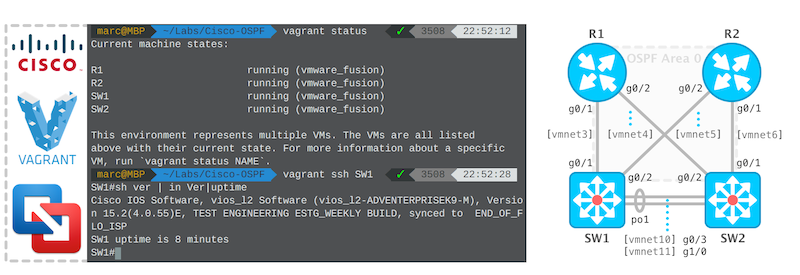$ vagrant box add precise64 You can find more boxes at Vagrant Cloud Now create a test directory and cd into the. Run with sudo and no arguments, the macinbox tool will create and add a Vagrant VMware box named 'macinbox' which boots fullscreen to the desktop of the 'vagrant' user: $ sudo macinbox. Please be patient, as this may take a while. (On a 2.5 GHz MacBookPro11,5 it takes about 11 minutes, 30 seconds.).
In this tutorial you will be able to install GitLab Community Edition locally on your mac using a vagrant box. This tutorial has been tested with macOS 10.15 and at the time of writing this tutorial, the latest version of GitLab CE is 12.9.3 and the latest version of Ubuntu is 18.04 (bionic64).

Required
First you must make sure all the following are installed.
- Vagrant - download vagrantup.com
- Virtual Box - download virtualbox.org
- Github Desktop (Optional for section 8) - download desktop.github.com
NOTE: Ruby versions 2.0 and above are included by default in macOS releases since at least El Capitan (10.11).
You should already have ruby installed so lets check this first.
This should output something like.
1. Create the vagrant file
At first in the terminal make the directory that will be used for the GitLab CE installation and set it as default, so for this example 'gitlab-local'. Kmsauto net 2016 windows 10 & office 2016 activator.
Then create a vagrant file.
Now open this file.
And replace the content with the following - you may need to change the forwarded_port and private_network to your own settings.
Now startup the vagrant box, this will initially take a while to install all the required files such as Gitlab CE.
Change the host file to recognise http://gitlab.local in your browser by opening the following which should also ask for your password.
Then add the following line at the bottom and save it.
2. Change the default hosting url (gitlab.example.com) for Gitlab CE
Vagrant Box Images
Access the Ubuntu terminal of the virtual box.
Now in the same terminal window edit the following file.
And find and replace.
With.
Then enter the following for the change to take effect.
3. Login to GitLab CE dashboard and change your user details
Open your browser with url http://gitlab.local. The first time around it will ask you to change your password.
Once done it will redirect you to the login page. By default the username is root so just enter this and your new password.
Now you should have access to the Gitlab CE Dashboard.
4. Edit the user account
First thing you should do is change your user details, so choose Settings and change your 'Email' and 'Full name' then press the 'Update profile settings' button.
You will receive an email just to confirm that it's exists. If the external_url has worked correctly the link in the email will work fine.
And then edit your username by selecting Account. Apowersoft screen recorder getintopc.

5. Create new repo
Create a new project so for this example I have used first-project.
You will be asked to first generate a SSH key.
6. Generate a new SSH key
Open a new terminal window and enter the following.
Then enter the filename you want the key to be named, just press return if you want to keep the default generated name but I would suggest using a custom name and remember to include the full directory in the filename like below. Bluestacks for mac settings.
Now just press enter twice to keep the passphrase empty.
Macos Vagrant Box Ubuntu
Open the public key with your naming above.

You will have a line of random code begining with 'ssh-rsa' so copy this for use with GitLab.
Go back to the GitLab CE dashboard and press the Add SSH Key and paste the public key then press Add key.
You should get an email to confirm this.
7. Access the new repo via the terminal (or with the 'GitHub Desktop app' see section 8)
First open the following file and link your ip/url to your key.
And add the following.
So now you can clone the repo by entering this in the terminal.
It will initially ask you the below, so just enter 'yes'.
This should be working fine.
Macos Vagrant Box Centos
8. Access the new repo with the GitHub Desktop app
With the Github Desktop application things work a little different regarding accessing your repos. So lets start by selecting Settings then Access Tokens on the left navigation.
At first enter a name - so for this example 'First Project' and select the api checkbox. Then press the 'Create personal access token' button.
The page should refresh and generate a code under Your New Personal Access Token. Make sure to get a copy of this code because we will need to use this in the Github Desktop application.
Now select the 'Your Gitlab Name / first-project' repo.
On the following page choose the Clone dropdown button and highlight either the http or https that appears so for example.
Now launch the GitHub Desktop app and choose 'Clone a Repository from the Internet..'.
Input the repo url and the destination folder.
Repository URL: http://gitlab.local/your-gitlab-name/first-project.git
Local Path: /Users/[username]/gitlab-local-repos/first-project
Now the first time doing this you will be asked for the Authentication Login so add your username (for this example 'Your Gitlab Name') which you used to access the GitLab dashboard and the password which should be the generated 'Personal Access Token'.
Now you should get the cloning progress bar and it will have synced the repo of your local GitLab CE.
Create Macos Vagrant Box
I hope this has been helpful.
